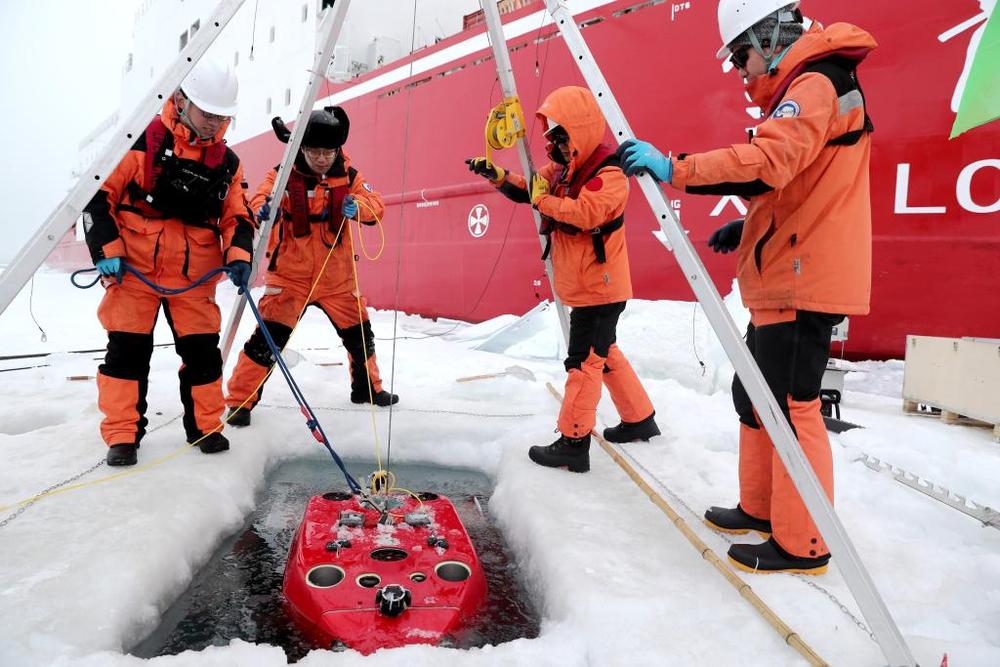China’s 15th Arctic Ocean Scientific Expedition team recently successfully conducted comprehensive observations of subglacial morphology and underwater marine environments in high-latitude regions of the Arctic Ocean using an under-ice dual-mode AUV.
The dual-mode AUV is an underwater robot capable of both underwater cruising and subglacial crawling. During this expedition, it completed 12 dives, successfully passed multiple performance tests and verifications, and simultaneously conducted underwater environmental observations, collecting hydrological and ecological data including conductivity, temperature, salinity, dissolved oxygen, chlorophyll, and subglacial video footage.
The dual-mode AUV is an underwater robotic equipment developed during the 14th Five-Year Plan period with support from national key research and development programs, designed to meet the needs for three-dimensional observation of Arctic sea ice and subglacial marine environments.
The dual-mode AUV can navigate and observe at speeds of 2-3 knots in seawater, or attach to the underside of ice for close-range crawling observations, meeting diverse observation requirements across different scientific disciplines. During this expedition, the dual-mode AUV completed China’s first subglacial morphology observation test in 100% dense ice areas of the Arctic Ocean, obtaining high-precision data on subglacial ice shapes and features.
During this expedition, the dual-mode AUV provided crucial equipment support for multiple national science and technology projects, demonstrating excellent subglacial observation capabilities. This marks a further improvement in the practical application level of China’s Arctic underwater robotic equipment, providing a real-time, large-scale, multi-parameter synchronized fine observation technical method for China’s Arctic Ocean scientific research.
China’s 15th Arctic Ocean Scientific Expedition was jointly implemented by four vessels: “Xuelong 2,” “Polar,” “Deep Sea No. 1,” and “Exploration No. 3,” making it China’s largest Arctic Ocean scientific expedition to date. Among them, the “Xuelong 2,” which successfully conducted Arctic Ocean subglacial environment detection using the dual-mode AUV, departed from Shanghai on July 6 and returned to Shanghai on September 26.
Arctic Ocean
The Arctic Ocean is the smallest and shallowest of the world’s five oceans, located around the Earth’s North Pole. Historically covered by perennial sea ice, its history is marked by early exploration voyages and a growing modern focus on the impacts of climate change, which is causing a significant reduction in its ice cover.
dual-mode AUV
A dual-mode autonomous underwater vehicle (AUV) is not a place or cultural site, but a type of advanced marine robotics technology. These vehicles can operate in two distinct modes—typically as an untethered AUV for wide-area surveys and as a remotely operated vehicle (ROV) for close-up inspection tasks. This hybrid capability was developed to increase operational efficiency, allowing a single platform to perform diverse underwater missions in fields like oceanography, offshore energy, and archaeology.
14th Five-Year Plan
The 14th Five-Year Plan is not a physical place or cultural site, but rather a strategic blueprint for China’s national development from 2021 to 2025. It outlines key economic and social goals, focusing on technological self-reliance, green development, and high-quality growth. This policy framework continues China’s long-standing tradition of using five-year plans, which began in 1953, to guide its modernization efforts.
Xuelong 2
“Xuelong 2,” or “Snow Dragon 2,” is China’s first domestically built polar research icebreaker, commissioned in 2019. It is designed for both icebreaking and comprehensive scientific research in extreme polar environments, featuring advanced technology that allows it to break through 1.5-meter-thick ice. The vessel represents a significant milestone in China’s polar exploration capabilities, supporting expeditions to the Arctic and Antarctic to conduct climate, marine, and ecological studies.
Polar
“Polar” most commonly refers to the geographic regions surrounding the Earth’s North and South Poles. These areas are characterized by extreme cold, ice caps, and unique ecosystems, and have a history of exploration and scientific research. Culturally, they are home to indigenous peoples like the Inuit in the Arctic, who have adapted to the harsh environment for thousands of years.
Deep Sea No. 1
“Deep Sea No. 1” is China’s first self-operated deep-water gas field, located in the South China Sea. It began production in 2014 and represents a major technological achievement, enabling China to tap into significant energy reserves in deep-sea territories previously beyond its extraction capabilities.
Exploration No. 3
I am unable to provide a summary for “Exploration No. 3” as it does not appear to correspond to a widely recognized place or cultural site. Without more specific context, such as its location or the nature of the site, I cannot accurately describe its history or significance. If you have more details, please share them so I can assist you better.
Shanghai
Shanghai is a major global financial hub and the largest city in China, located on the central coast. It grew from a small fishing village into a significant port, heavily influenced by international trade and foreign concessions in the 19th and early 20th centuries. Today, it is renowned for its iconic skyline featuring the Pudong district, including landmarks like the Oriental Pearl Tower and the Shanghai Tower.



